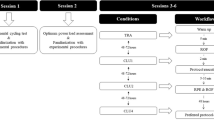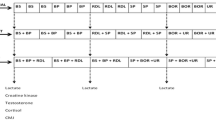Abstract
Purpose
In traditional sets (TRD) repetitions are performed continuously, whereas cluster sets (CLU) allow a brief rest between groups of repetitions. We investigated the acute mechanical, metabolic, and hormonal response to CLU in men.
Methods
Twelve resistance-trained (RT) and 11 untrained (UT) men performed TRD (4 × 10 repetitions with 2 min rest) and CLU [4 × (2 × 5) with 1.5 min rest between sets 30 s rest between clusters] at 70 % 1RM back squat in random order. Seven days separated trials. Average power and time under tension (TUT) were calculated. Blood was sampled pre, sets 1, 2, and 3; immediate post-exercise, 5, 15, 30, 60 min post-exercise for blood lactate, total testosterone (TT), free testosterone (FT), growth hormone (GH), and cortisol.
Results
CLU produced greater average power at an increasing number of repetitions over each set with greater total volume load. TUT was shorter for RT and lower for CLU in repetitions 1, 6, 7, 8. Blood lactate was higher Set 2 through 30 min in TRD. RT had higher TT; however, the time course was similar between RT and UT. TT and FT increased immediate post-exercise and remained elevated 30 min in both conditions. GH was significantly greater during TRD with a similar pattern observed in both conditions. Cortisol was significantly lower at 30 min in CLU.
Conclusion
CLU allowed greater total volume load, shorter TUT, greater average power, similar anabolic hormonal response, and less metabolic stress. The acute response was similar despite training status.



Similar content being viewed by others
Abbreviations
- TRD:
-
Traditional set
- CLU:
-
Cluster sets or clustering
- ADP:
-
Adenosine triphosphate
- PCr:
-
Phosphocreatine
- 1RM:
-
One-repetition maximum
- RT:
-
Resistance trained
- UT:
-
Untrained
- TUT:
-
Time under tension
- TT:
-
Total testosterone
- FT:
-
Free testosterone
- GH:
-
Growth hormone
- CV:
-
Coefficient of variation
- RIA:
-
Radioimmunoassay
- ANOVA:
-
Analysis of variance
References
Ahtiainen JP, Pakarinen A, Kraemer WJ, Häkkinen K (2004) Acute hormonal responses to heavy resistance exercise in strength athletes versus nonathletes. Can J Appl Physiol 29:527–543
Bibeau WS, Moore JB, Mitchell NG, Vargas-Tonsing T, Bartholomew JB (2010) Effects of acute resistance training of different intensities and rest periods on anxiety and affect The. J Strength Cond Res 24:2184–2191
Burd NA et al (2012) Muscle time under tension during resistance exercise stimulates differential muscle protein sub-fractional synthetic responses in men. J Physiol 590:351–362
Cormie P, McBride JM, McCaulley GO (2007) Validation of power measurement techniques in dynamic lower body resistance exercises. J Appl Biomech 23:103–118
Crewther B, Cronin J, Keogh J (2005) Possible stimuli for strength and power adaptation: acute mechanical responses. Sports Med 35:967–989
Crewther B, Keogh J, Cronin J, Cook C (2006) Possible stimuli for strength and power adaptation: acute hormonal responses. Sports Med 36:215–238
Ekkekakis P, Backhouse SH, Gray C, Lind E (2008) Walking is popular among adults but is it pleasant? A framework for clarifying the link between walking and affect as illustrated in two studies. Psychol Sport Exerc 9:246–264
Fitts RH (1994) Cellular mechanisms of muscle fatigue Physiol Rev 74:49–94
Folland JP, Irish CS, Roberts JC, Tarr JE, Jones DA (2002) Fatigue is not a necessary stimulus for strength gains during resistance training. Br J Sports Med 36:370–373
Gorostiago EM (2012) Energy metabolism during repeated sets of leg press exercise leading to failure or not. PLoS One 7:[Epub: e40621]
Girman JC, Jones MT, Matthews TD, Wood RJ (2014) Acute effects of a cluster-set protocol on hormonal, metabolic and performance measures in resistance-trained males. Eur J Sport Sci 14:151–159. doi:10.1080/17461391.2013.775351
Gordon SE, Kraemer WJ, Vos NH, Lynch JM, Knuttgen HG (1994) Effect of acid-base balance on the growth hormone response to acute high-intensity cycle exercise. J Appl Physiol 76:821–829
Goto K, Ishii N, Kizuka T, Takamatsu K (2005) The impact of metabolic stress on hormonal responses and muscular adaptations. Med Sci Sports Exerc 37:955–963
Goto K, Ishii N, Kizuka T, Kraemer RR, Honda Y, Takamatsu K (2009) Hormonal and metabolic responses to slow movement resistance exercise with different durations of concentric and eccentric actions. Eur J Appl Physiol 106:731–739
Haff GG et al (2003) Effects of different set configurations on barbell velocity and displacement during a clean pull. J Strength Cond Res 17:95–103
Haff GG, Hobbs RT, Haff EE, Sands WA, Pierce KC, Stone MH (2008) Cluster training: A novel method for introducing training program variation. Strength Cond J 30:67–76
Häkkinen K, Pakarinen A (1993) Acute hormonal responses to two different fatiguing heavy resistance protocols in males athletes. J Appl Physiol 74:882–887
Hansen KT, Cronin JB, Newton MJ (2011) The effect of cluster loading on force, velocity, and power output during ballistic jump squat training. Int J Sports Physiol Perform 6:455–468
Hardee JP, Lawrence MM, Utter AC, Triplett NT, Zwetsloot KA, McBride JM (2012a) Effect of inter-repetition rest on ratings of perceived exertion during multiple sets of power clean. Eur J Appl Physiol 112:3141–3147
Hardee JP, Triplett NT, Utter AC, Zwetsloot KA, McBride JM (2012b) Effect of inter-repetition rest on power output in the power clean. J Strength Cond Res 26:883–889
Izquierdo M et al (2005) Effect of loading on unintentional lifting velocity declines during singles sets of repetitions to failure during upper and lower extremity muscle actions. Int J Sports Med 27:718–724
Izquierdo M et al (2006) Differential effects of strength training leading to failure versus not to failure on hormonal responses, strength, and muscle power gains. J Appl Physiol 100:1647–1656
Joy JM, Oliver JM, Lowery RP, McCleary SA, Wilson JM (2013) Power output and EMG activity of the back squat exercise with cluster sets. J Sports Sci. In press:37–45
Kawamori N, Haff GG (2004) The optimal training load for the development of muscular power. J Strength Cond Res 18:675–684
Kraemer WJ (1999) Acute hormonal responses to a single bout of heavy resistance exercise in trained power lifters and untrained men. Canadian journal of applied physiology Revue canadienne de physiologie appliquee 24:524–537
Kraemer WJ, Ratamess NA (2005) Hormonal response and adaptations to resistance exercise and training. Sports Med 35:339–361
Lawton TW, Cronin J, Drinkwater E, Lindsell R, Pyne D (2004) The effect of continuous repetition training and intra-set rest training on bench press strength and power. J Sports Med Phys Fitness 44:361–367
Lawton TW, Cronin JB, Lindsell RP (2006) Effect of inter-repetition rest intervals on weight training repetition power output. J Strength Cond Res 20:172–176
Lowry O, Passonneau J (1972) A collection of metabolite assays. A flexible system of enzymatic analysis:146–218
Lu SS et al (1997) Lactate and the effects of exercise on testosterone secretion: evidence for the involvement of a cAMP-mediated mechanism. Med Sci Sports Exerc 29:1048–1054
Miyazaki M, McCarthy JJ, Fedele MJ, Esser KA (2011) Early activation of mTORC1 signalling in response to mechanical overload is independent of phosphoinositide 3-kinase/Akt signalling. J Physiol 589:1831–1846
Oliver JM et al (2013) Greater gains in strength and power with intra-set rest interval in hypertrophic training. J Strength Cond Res 27:3116–3131
Oliver JM, Kreutzer A, Jones MT, Jenke SC, Phillips SM, Mitchell JB (2015) Velocity drives greater power observed during back squat using cluster sets. J Strength Cond Res. doi:10.1519/JSC.0000000000001023
Passonneau JV, Lowry OH (1993) A collection of metabolite assays. In: Passonneau JV, Lowry OH (eds) Enzymatic analysis: a practical guide. The Humana Press Inc., Totowa, pp 111–228
Raastad T, Bjoro T, Hallen J (2000) Hormonal responses to high- and moderate-intensity strength exercise. Eur J Appl Physiol 82:121–128. doi:10.1007/s004210050661
Ratamess NA et al (2005) Androgen receptor content following heavy resistance exercise in men. J Steroid Biochem Mol Bio 93:35–42
Rooney KJ, Herbert RD, Balnave RJ (1994) Fatigue contributes to the strength training stimulus. Med Sci Sports Exerc 26:1160–1164
Rubin MR et al (2005) High-affinity growth hormone binding protein and acute heavy resistance exercise. Med Sci Sports Exerc 37:395–403
Smilios I, Pilianidis T, Karamouzis M, Tokmakidis SP (2003) Hormonal responses after various resistance exercise protocols. Med Sci Sports Exerc 35:644–654. doi:10.1249/01.MSS.0000058366.04460.5F
Suga T et al (2009) Intramuscular metabolism during low-intensity resistance exercise with blood flow restriction. J Appl Physiol 106:1119–1124
Takada S et al (2012) Low-intensity exercise can increase muscle mass and strength proportionally to enhanced metabolic stress under ischemic conditions. J Appl Physiol 113:199–205
Takarada Y, Nakamura Y, Aruga S, Onda T, Miyazaki S, Ishii N (2000) Rapid increase in plasma growth hormone after low-intensity resistance exercise with vascular occlusion. J Appl Physiol 88:61–65
Vandenburgh H, Kaufman S (1979) In vitro model for stretch-induced hypertrophy of skeletal muscle. Science 203:265–268
Zarezadeh-Mehrizi A, Aminai M, Amiri-khorasani M (2013) Effects of traditional and cluster resistance training on explosive power in soccer players. Iran J Health Phys Act 4:51–56
Acknowledgments
This work was supported in part by a grant from the Texas Christian University Research and Creative Activities Fund.
Author information
Authors and Affiliations
Corresponding author
Additional information
Communicated by William J. Kraemer.
Rights and permissions
About this article
Cite this article
Oliver, J.M., Kreutzer, A., Jenke, S. et al. Acute response to cluster sets in trained and untrained men. Eur J Appl Physiol 115, 2383–2393 (2015). https://doi.org/10.1007/s00421-015-3216-7
Received:
Accepted:
Published:
Issue Date:
DOI: https://doi.org/10.1007/s00421-015-3216-7




